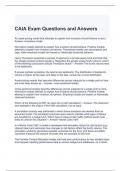Lecture notes
Lecture notes: Forensic Psychology (PY-FPSSIN)
- Institution
- Bath Spa University (BSU)
Full typed lecture notes the for year one Forensic Psychology module. These notes are bullet-pointed for easy, fast reading and the highlighted keywords and headings allow for information to be found quickly.
[Show more]







